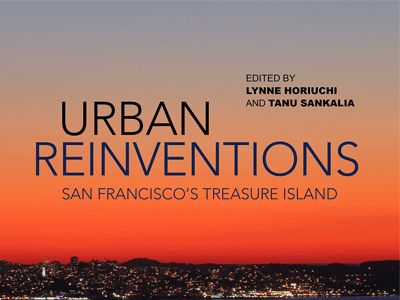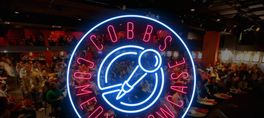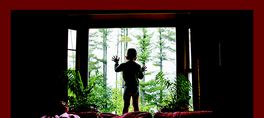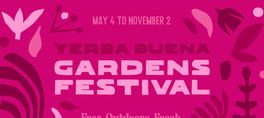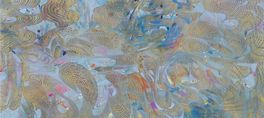Co-editors Lynne Horiuchi and Tanu Sankalia discuss their fascinating work, Urban Reinventions: San Francisco's Treasure Island.
When it was built in 1937, Treasure Island was considered to be one of the largest man-made islands in the world. Located in the middle of San Francisco Bay, the 400-acre island was constructed out of dredged bay mud in a remarkable feat of Depression-era civil engineering by the US Army Corps of Engineers. Its alluring name is an allusion to the fabled remnants of the California Gold Rush found in the ocean sediment that formed the island.
This collection of essays tells the story of San Francisco's Treasure Island--an artificial, disconnected island that has paradoxically been central to the city's urban ambitions. Conceived as a site for San Francisco's first airport in an age of automobile and air transport, Treasure Island hosted the Golden Gate International Exposition (GGIE) in 1939 and 1940, celebrating the completion of the Golden Gate and the San Francisco-Oakland Bay Bridges. With particular focus on Asia and Latin America, the GGIE promoted peace, harmony, and commerce in the Pacific. Treasure Island's planned use as an airport was scuttled when World War II abruptly reversed the exposition's message of Pacific unity, and the US government developed Treasure Island and the adjacent Yerba Buena Island into a naval training and transfer station, which processed 4,500,000 military personnel on their way to the Pacific theater.
In the midst of a twenty-first-century high-tech boom and in one of the most expensive real-estate markets in the world, the city of San Francisco and its developers have proposed an ambitious model of military base reuse and green urbanism--a new eco-city of about 19,000 residents on Treasure Island and Yerba Buena Island. The project is synonymous with a growing global trend toward large-scale, capital-intensive land developments envisioned around ideas of sustainability and spectacular place making. Seen against the successive history of development, future visions for Treasure Island are part of a process of building and erasure that Horiuchi and Sankalia call urban reinventions. This is a process of radical change in which artificial, detached, and delimited sites such as Treasure Island provide an ideal plane for tabula rasa planning driven by property, capital, and state control.
With essays by contributors well known for their interdisciplinary work, Urban Reinventions demonstrates how a single site may be interpreted in multiple ways: as an artificial island, world's fair site, military installation, a semi-derelict relic of past lives, a toxic site of nuclear waste, and a future eco-city and major real estate development. The volume offers a wide spectrum of critiques of race, imperialism, gendered Orientalism, military land use, property capital exchange, new eco-cities, sustainability, and waste as a byproduct of development.
The book will be of interest to general readers as well as teachers, scholars, and practitioners in the fields of geography, architecture, city planning, urban design, history, environmental studies, American studies, Asian studies, and military history, among others.
show less
When it was built in 1937, Treasure Island was considered to be one of the largest man-made islands in the world. Located in the middle of San Francisco Bay, the 400-acre island was constructed out of dredged bay mud in a remarkable feat of Depression-era civil engineering by the US Army Corps of Engineers. Its alluring name is an allusion to the fabled remnants of the California Gold Rush found in the ocean sediment that formed the island.
This collection of essays tells the story of San Francisco's Treasure Island--an artificial, disconnected island that has paradoxically been central to the city's urban ambitions. Conceived as a site for San Francisco's first airport in an age of automobile and air transport, Treasure Island hosted the Golden Gate International Exposition (GGIE) in 1939 and 1940, celebrating the completion of the Golden Gate and the San Francisco-Oakland Bay Bridges. With particular focus on Asia and Latin America, the GGIE promoted peace, harmony, and commerce in the Pacific. Treasure Island's planned use as an airport was scuttled when World War II abruptly reversed the exposition's message of Pacific unity, and the US government developed Treasure Island and the adjacent Yerba Buena Island into a naval training and transfer station, which processed 4,500,000 military personnel on their way to the Pacific theater.
In the midst of a twenty-first-century high-tech boom and in one of the most expensive real-estate markets in the world, the city of San Francisco and its developers have proposed an ambitious model of military base reuse and green urbanism--a new eco-city of about 19,000 residents on Treasure Island and Yerba Buena Island. The project is synonymous with a growing global trend toward large-scale, capital-intensive land developments envisioned around ideas of sustainability and spectacular place making. Seen against the successive history of development, future visions for Treasure Island are part of a process of building and erasure that Horiuchi and Sankalia call urban reinventions. This is a process of radical change in which artificial, detached, and delimited sites such as Treasure Island provide an ideal plane for tabula rasa planning driven by property, capital, and state control.
With essays by contributors well known for their interdisciplinary work, Urban Reinventions demonstrates how a single site may be interpreted in multiple ways: as an artificial island, world's fair site, military installation, a semi-derelict relic of past lives, a toxic site of nuclear waste, and a future eco-city and major real estate development. The volume offers a wide spectrum of critiques of race, imperialism, gendered Orientalism, military land use, property capital exchange, new eco-cities, sustainability, and waste as a byproduct of development.
The book will be of interest to general readers as well as teachers, scholars, and practitioners in the fields of geography, architecture, city planning, urban design, history, environmental studies, American studies, Asian studies, and military history, among others.
Co-editors Lynne Horiuchi and Tanu Sankalia discuss their fascinating work, Urban Reinventions: San Francisco's Treasure Island.
When it was built in 1937, Treasure Island was considered to be one of the largest man-made islands in the world. Located in the middle of San Francisco Bay, the 400-acre island was constructed out of dredged bay mud in a remarkable feat of Depression-era civil engineering by the US Army Corps of Engineers. Its alluring name is an allusion to the fabled remnants of the California Gold Rush found in the ocean sediment that formed the island.
This collection of essays tells the story of San Francisco's Treasure Island--an artificial, disconnected island that has paradoxically been central to the city's urban ambitions. Conceived as a site for San Francisco's first airport in an age of automobile and air transport, Treasure Island hosted the Golden Gate International Exposition (GGIE) in 1939 and 1940, celebrating the completion of the Golden Gate and the San Francisco-Oakland Bay Bridges. With particular focus on Asia and Latin America, the GGIE promoted peace, harmony, and commerce in the Pacific. Treasure Island's planned use as an airport was scuttled when World War II abruptly reversed the exposition's message of Pacific unity, and the US government developed Treasure Island and the adjacent Yerba Buena Island into a naval training and transfer station, which processed 4,500,000 military personnel on their way to the Pacific theater.
In the midst of a twenty-first-century high-tech boom and in one of the most expensive real-estate markets in the world, the city of San Francisco and its developers have proposed an ambitious model of military base reuse and green urbanism--a new eco-city of about 19,000 residents on Treasure Island and Yerba Buena Island. The project is synonymous with a growing global trend toward large-scale, capital-intensive land developments envisioned around ideas of sustainability and spectacular place making. Seen against the successive history of development, future visions for Treasure Island are part of a process of building and erasure that Horiuchi and Sankalia call urban reinventions. This is a process of radical change in which artificial, detached, and delimited sites such as Treasure Island provide an ideal plane for tabula rasa planning driven by property, capital, and state control.
With essays by contributors well known for their interdisciplinary work, Urban Reinventions demonstrates how a single site may be interpreted in multiple ways: as an artificial island, world's fair site, military installation, a semi-derelict relic of past lives, a toxic site of nuclear waste, and a future eco-city and major real estate development. The volume offers a wide spectrum of critiques of race, imperialism, gendered Orientalism, military land use, property capital exchange, new eco-cities, sustainability, and waste as a byproduct of development.
The book will be of interest to general readers as well as teachers, scholars, and practitioners in the fields of geography, architecture, city planning, urban design, history, environmental studies, American studies, Asian studies, and military history, among others.
read more
When it was built in 1937, Treasure Island was considered to be one of the largest man-made islands in the world. Located in the middle of San Francisco Bay, the 400-acre island was constructed out of dredged bay mud in a remarkable feat of Depression-era civil engineering by the US Army Corps of Engineers. Its alluring name is an allusion to the fabled remnants of the California Gold Rush found in the ocean sediment that formed the island.
This collection of essays tells the story of San Francisco's Treasure Island--an artificial, disconnected island that has paradoxically been central to the city's urban ambitions. Conceived as a site for San Francisco's first airport in an age of automobile and air transport, Treasure Island hosted the Golden Gate International Exposition (GGIE) in 1939 and 1940, celebrating the completion of the Golden Gate and the San Francisco-Oakland Bay Bridges. With particular focus on Asia and Latin America, the GGIE promoted peace, harmony, and commerce in the Pacific. Treasure Island's planned use as an airport was scuttled when World War II abruptly reversed the exposition's message of Pacific unity, and the US government developed Treasure Island and the adjacent Yerba Buena Island into a naval training and transfer station, which processed 4,500,000 military personnel on their way to the Pacific theater.
In the midst of a twenty-first-century high-tech boom and in one of the most expensive real-estate markets in the world, the city of San Francisco and its developers have proposed an ambitious model of military base reuse and green urbanism--a new eco-city of about 19,000 residents on Treasure Island and Yerba Buena Island. The project is synonymous with a growing global trend toward large-scale, capital-intensive land developments envisioned around ideas of sustainability and spectacular place making. Seen against the successive history of development, future visions for Treasure Island are part of a process of building and erasure that Horiuchi and Sankalia call urban reinventions. This is a process of radical change in which artificial, detached, and delimited sites such as Treasure Island provide an ideal plane for tabula rasa planning driven by property, capital, and state control.
With essays by contributors well known for their interdisciplinary work, Urban Reinventions demonstrates how a single site may be interpreted in multiple ways: as an artificial island, world's fair site, military installation, a semi-derelict relic of past lives, a toxic site of nuclear waste, and a future eco-city and major real estate development. The volume offers a wide spectrum of critiques of race, imperialism, gendered Orientalism, military land use, property capital exchange, new eco-cities, sustainability, and waste as a byproduct of development.
The book will be of interest to general readers as well as teachers, scholars, and practitioners in the fields of geography, architecture, city planning, urban design, history, environmental studies, American studies, Asian studies, and military history, among others.
show less
Date/Times:
1491 Shattuck Avenue, Berkeley, CA 94710
The Best Events
Every Week in Your Inbox
From Our Sponsors
UPCOMING EVENTS
Great suggestion! We'll be in touch.
Event reviewed successfully.
